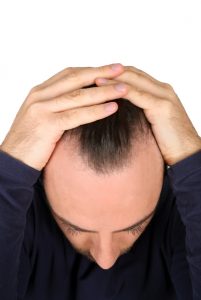Hair loss affects millions of men across the United States and impacts far more than personal appearance. Rather than just being a term to describe one disorder, hair loss is a general term used to label thinning hair and excessive shedding of the hair. Many different hair loss types exist, and some forms are related to underlying medical conditions and the use of prescription medications.

- Male pattern baldness, sometimes called androgenic alopecia, is the most common form of hair loss among men, accounting for more than 95 percent of all cases of hair loss in men.
- Scientists have discovered a genetic factor that plays a role in male pattern baldness. This trait can be passed to a man from his mother or his father.
- Male pattern baldness causes hair to be shed at an accelerated rate; typically of more than 150 hairs lost per day.
- Thinning often starts around the hairline with loss at the front of the scalp. This is sometimes called a "receding hairline."
- Male pattern baldness typically progresses over time without treatment and can result in a U-shaped region of baldness with a border of hair along the sides and front.

66 percent of men aged 35 and under have a noticeable degree of thinning or loss due to male pattern baldness.
Male pattern baldness will strike the majority of American men at some point in their lives; however, the degree to which the condition is noticeable can vary greatly from man to man.
- By the age of 50, 85 percent of men will have some degree of thinning or loss from male pattern baldness.
- 66 percent of men aged 35 and under have a noticeable degree of thinning or loss due to male pattern baldness.
- Only 25 percent of male pattern baldness cases begin in men who are 21 and younger.
Men with male pattern baldness have hair follicles that are hypersensitive to the effects of a hormone called dihydrotestosterone(DHT). This androgen or male sex hormone is present in the scalps of all men, but in those with male pattern baldness, the hormone causes the hair follicles to shrink in size. Since the follicles are the openings through which hair strands emerge, the effect of the reduced size of the follicles is hair that is thinner and weaker than normal growth. The smaller strands result in thinning, and the hairs are shed more rapidly due to the condition of the follicles. As the follicles continue to shrink, they eventually become too narrow for hair growth to continue.

An experienced family practitioner or internist can often diagnose male pattern baldness based on sight alone. In some cases, a doctor may order blood tests to rule out any underlying medical causes for hair loss and thinning before assigning a diagnosis of male pattern baldness.

The Norwood Hamilton Scale is a way to measure the extent of male pattern baldness, and is the generally accepted standard when describing hair loss in general.
There is no pill or cream that will immediately cure androgenic alopecia and keep it from reoccurring in the future. RegenePure Precision's high grade 5% minoxidil formula is clinically shown to stop the progression of male pattern baldness and encourage regrowth. The fine mist applicator spray ensures that the formula reaches the skin for maximum effectiveness and makes RegenePure Precision an effective, safe treatment for androgenic alopecia.
 Regenepure Precision 5% Minoxidil Spray is specially designed for men. The fine mist applicator ensures a clean and targeted application of minoxidil without any cleanup. The fine mist applicator ensures absolute accuracy, targeting problem areas with ease. The direct contact spray will also help provide the scalp with the oxygen and nutrients it needs to stimulate healthy hair regrowth.
Regenepure Precision 5% Minoxidil Spray is specially designed for men. The fine mist applicator ensures a clean and targeted application of minoxidil without any cleanup. The fine mist applicator ensures absolute accuracy, targeting problem areas with ease. The direct contact spray will also help provide the scalp with the oxygen and nutrients it needs to stimulate healthy hair regrowth.